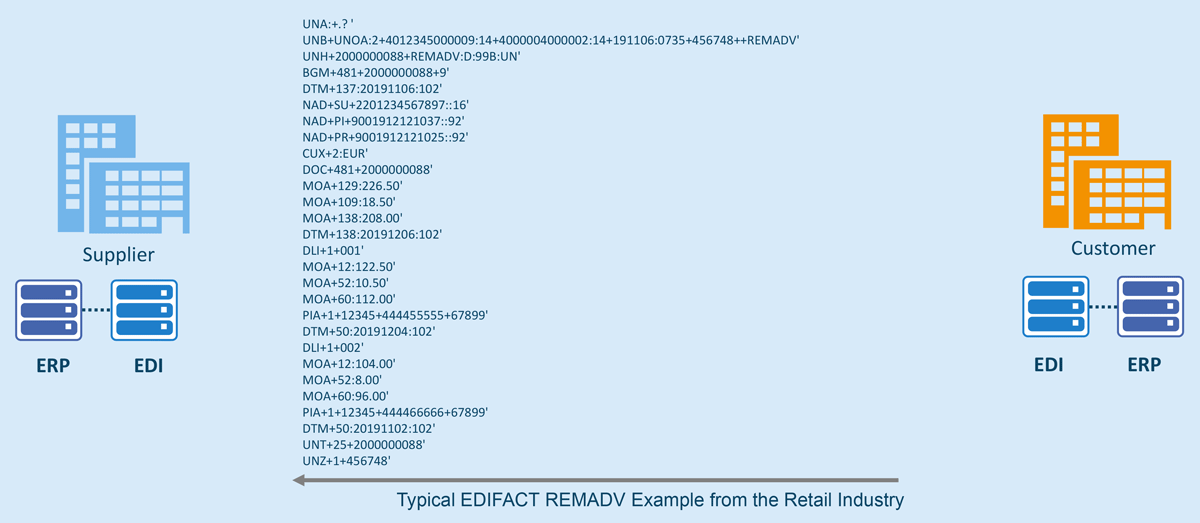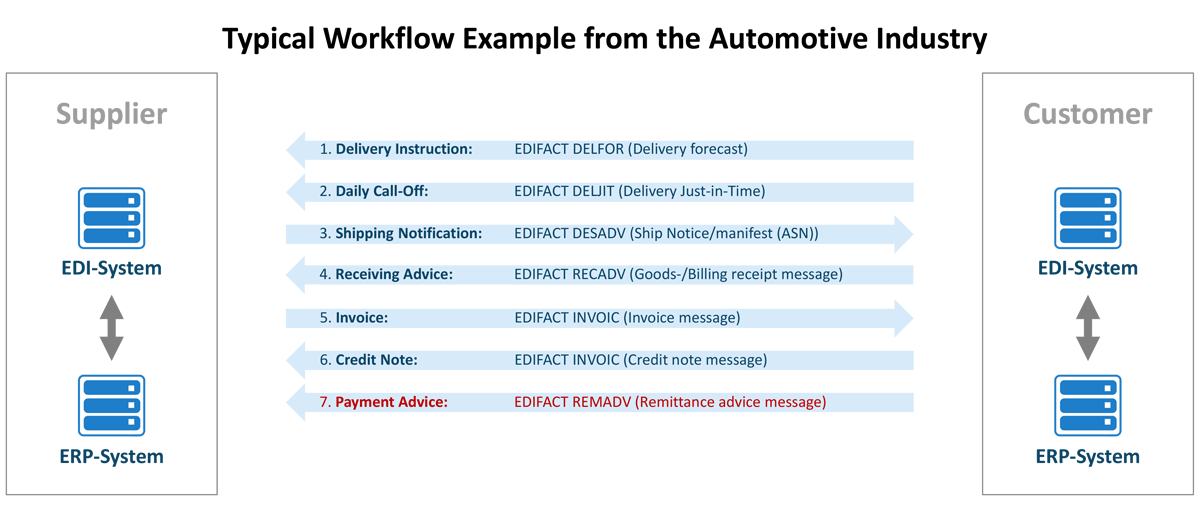
What is an EDIFACT REMADV Message?
An EDIFACT REMADV (REMittance ADVice) message is used by the customer to inform their supplier at the end of an EDI workflow when and how much money they will transfer for the received goods or services or that the transfer has just taken place.
The REMADV message follows the EDI message standard UN/EDIFACT and is used in conjunction with EDI INVOIC messages.
The use of the EDIFACT REMADV Message
The supplying organization would first create an EDI invoice message or several invoice messages to their customer. When using EDIFACT as the EDI standard, this would be as an INVOIC message.
A REMADV message is particularly useful if multiple invoices are settled in a single payment. With an EDIFACT REMADV, the supplier can use this information to relate several invoices to a payment.
As the usage of a REMADV message is optional, it is not as common as some of the other practically mandatory document types in an EDI workflow. These REMADV messages tend to be sent between the larger customers and their suppliers, dependent on their specific business practices.
How does a typical EDIFACT REMADV Structure look like?

Remittance advice messages contain various data regarding the payment of goods. The remittance advice can furthermore refer to different business processes and the corresponding financial transactions.
EDI Remittance Advices follow a set structure of segments and elements specific to the EDIFACT standard. The customer’s own in house ERP system like e.g., SAP, would create a message containing all the required invoice bundling information, e.g., in SAP IDoc, which is then translated into the customer’s required EDI standard. The EDI solution doing the conversion can be an EDI Cloud Service or EDI software for in-house usage.
A typical EDIFACT REMADV message contains:
- Buyer and seller information
- Previous Invoice details like invoice number and amount
- Surcharge or reduction reasons and applied discounts
- Partial payments that have already been transferred or are still due, etc.
Processing of the EDIFACT REMADV Message
Once the customer has received an INVOIC message, their EDI system will check the contents against the available data. If this message is syntactically correct, the ERP system will be able to update the previously stored details with this new information. A functional acknowledge may then be sent back to confirm that the message was received and accepted technically. A Remittance Advice is provided afterward to the supplier, typically if several invoices are collected and settled in one payment.
The figure below shows the role of an EDIFACT REMADV message and which other message types are used in a Retail scenario:

The EDI Remittance Advice can be necessary as part of the so-called ten-day invoices. A supplier issues invoices for a larger number of delivery notes at the same time (usually covering around ten days and various purchase locations - for example, retail stores), which then are settled in one go.
The figure below shows an EDIFACT REMADV message and which other message types are used in an automotive scenario:

What are the equivalents of EDIFACT REMADV in other EDI Standard Formats?
EDIFACT is the current standard proposed by the UN and used across Europe and in most parts of Asia. UN/EDIFACT uses a single REMADV document to specify all invoices which are settled in one payment. Using the ANSI X12 standard, which is mostly used in North America, the 820 (Payment order (EFT)) would be sent. TRADACOMS is a standard in the UK retail sector where the equivalent is called SRMHDR.
Typical Errors when using the EDIFACT REMADV Message
Incorrect or unknown master data can cause issues. If you send references that the supplier does not recognize or understand the REMADV may not be accepted. For example
- Invoice numbers do not match in the supplier’s ERP system
- Discounts are applied without prior agreement
Benefits using EDI and the REMADV Message
Reduction of cost as previously manual jobs doing a settlement for each invoice can be optimized and automated
A REMADV allows suppliers to recognize payment errors early and automatically. This stabilizes the cash flow.
Better supplier ratings with key customers generating a lot of deliveries
Automate Invoicing and ease settlement through EDIFACT REMADV
EDI needs to be flexible, run stable, and can cost-effectively automate the invoicing process. At the same time operating EDI can be complicated and time-consuming.
The SEEBURGER BIS Platform provides EDI and other integrations schemes as a fully managed service in the SEEBURGER Cloud or a public cloud environment (e.g., Google, Azure, AWS, etc.) or as an on-premises software solution.
Fully managed services in the cloud deliver EDI combined with the needed high expertise. SEEBURGER has the expert team which manages your EDI solution, so you don’t need to be afraid of EDI errors, chargebacks, or because your supplier rating got hit.









